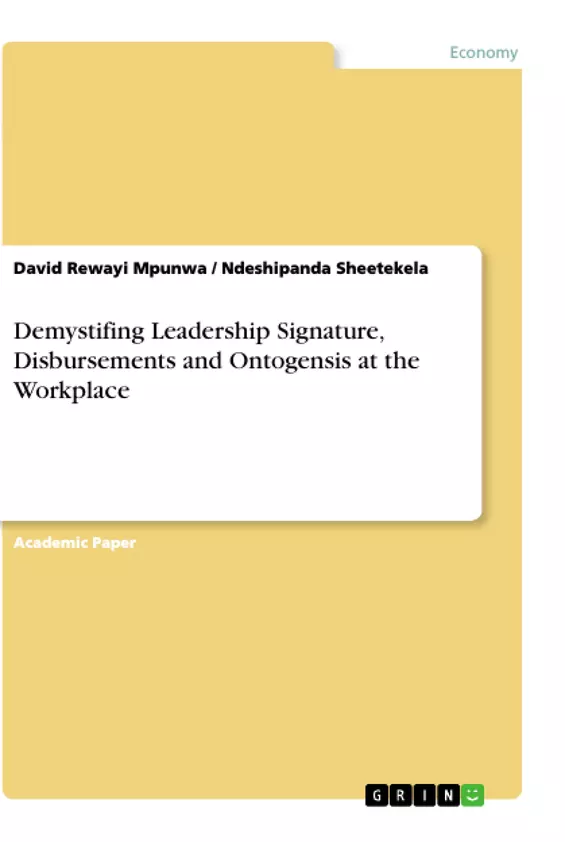The drive of this discourse was to analyse school leadership ontogenesis in Namibia. The paper analyses whether the gender of the heads disposes leadership in any way. It determines factors to dispose leadership and teacher performance in school. Furthermore, it looks at the style of leadership, that is implemented in the primary schools.
The deficiency of efficacious leadership in school configurations has been a venerable predicament and has prevailed since the state attained political autonomy in 1990. The rapid preponderance of high schools across the state since independence exacerbated the predicament with a plethora of these schools despite diverse attempts to titivate the quality of education delivery in schools.
It should be stressed that the interpretivist theoretical perspective was adopted in this study. This viewpoint implies that the emphasis is on crafting communicated concepts and is an approach that purposefully tries to unpack the reality of the situation within a specific contextual environment. The researcher argues that training of leadership results in effective performance.
The findings of this research show that fifty-three per cent of the school leaders were not trained on the leadership enhancement programme, while forty-seven per cent of the school leaders were trained. It is recommended that most of the school leaders be trained in the leadership development. The state needs to follow best practises in leadership ontogenesis such as practiced in Singapore, the United Kingdom, New Zealand and Austria. The school leadership furnishes a significant gathering of plethoric models for present school leadership ethos.
Inhaltsverzeichnis (Table of Contents)
- Chapter One: Introduction
- 1.1 Introduction
- 1.2 Background Of The Study
- 1.3 Statement Of The Problem
- 1.4 Objectives Of The Study
- 1.5 Research Questions
- 1.6 Hypothesis Testing
- 1.7 Significance Of The Study
- 1.8 Scope Of The Study
- 1.9 Limitation Of The Study
- 1.10 Organisation Of The Study
- 1.11 Conclusion
- Chapter 2: Literature Review
- 2.1 Introduction
- 2.2 Delineation of leadership Ontogenesis
- 2.2.1 The role of CEO Leadership
- 2.2.2 Leadership Signature
- 2.3 Theories of leadership Ontogenesis
- 2.3.1 A Holistic Theory for leadership Ontogenesis
- 2.3.2 Social Change theory for leadership ontogeny
- 2.3.3 Dynamic theory for leadership ontogenesis
- 2.3.4 Theories for Disbursements
- 2.4 Theoretical framework
- 2.4 Leadership Signature styles
- 2.4.2 Contingent leadership
- 2.4.3 Transactional leadership
- 2.4.4 Transformational leaders
- 2.4.5 Autocratic leadership
- 2.4.6 Democratic leadership
- 2.5 Cambietics in leadership Signatures
- 2.6 Gender influence leadership signatures
- 2.7 Factors influencing leadership and Performance
- 2.7.1 Leadership signature style and performance
- 2.7.2 Consultative leadership and performance
- 2.7.3 Organisational Culture Change
- 2.8 Methods of School leadership ontogenesis
- 2.9 Effect of good leadership corporate governance on corporate performance
- 2.9.1 Effective school leadership Signatures
- 2.10 Conclusion
- Chapter 3: Research Methodology
- 3.1 Introduction
- 3.2 Research design
- 3.2.1 Case study
- 3.2.2 Justification of the Case Study Approach
- 3.3 Research Philosophy
- 3.5 Sampling Strategy
- 3.5.1 population
- 3.5.2 Sample
- 3.5.3 Sampling techniques
- 3.6 Non-probability sampling techniques
- 3.6.1 Convenience Sampling
- 3.6.3 Purposive sampling
- 3.7 Sampling for the research study
- 3.8 Data Collection Instruments
- 3.8.1 Interview Method
- 3.8.2 Questionnaires
- 3.8.3 Procedure
- 3.9 Data Analysis
- 3.9.1 Evaluation of validity
- 3.9.2 Criterion Cogency
- 3.9.3 Predictive validity
- 3.9.4 Concurrent validity
- 3.10 Pilot Study
- 3.11 Ethical Considerations
- 3.11.1 The tenet of informed consent
- 3.11.2 The prerogative to anonymity and confidentiality
- 3.12 Conclusion
- Chapter Four: Findings
- 4.1 Introduction
- 4.2 Demographic Information
- 4.2.1 Three Primary Schools
- 4.2.2 School leadership Gender Representation
- 4.2.3 Leadership Age-Group
- 4.3.1 Leadership Ontogenesis programme
- 4.3.2 Satisfaction with the leadership ontogenesis programme in your school?
- Call for Leadership Cambietics
- Gender of the heads influences leadership in any way
- Leadership Signature styles being implemented in the three primary schools
Zielsetzung und Themenschwerpunkte (Objectives and Key Themes)
This study aims to demystify the nature of leadership signature, disbursements, and ontogenesis in the workplace, specifically focusing on primary school leadership in the Oshana region of Namibia. It seeks to understand how leadership development programs are executed, whether there is a call for change in leadership practices, and the potential influence of gender on leadership styles.
- Leadership Ontogenesis and its execution in primary schools
- The role of leadership signatures in shaping school leadership
- The call for changes and "cambietics" in leadership styles
- The impact of gender on leadership roles and practices
- Determinants of effective leadership and teacher performance
Zusammenfassung der Kapitel (Chapter Summaries)
Chapter One introduces the research topic, providing a comprehensive overview of the study's objectives, research questions, and significance. Chapter Two delves into a detailed literature review, exploring various theoretical frameworks and concepts related to leadership ontogenesis, signature styles, and factors influencing leadership effectiveness. Chapter Three outlines the research methodology employed, including the case study design, sampling techniques, data collection instruments, and data analysis procedures. Chapter Four presents the findings of the study, analyzing demographic information, leadership development programs, and leadership signature styles observed in the three primary schools. Chapter Five summarizes the key findings, draws conclusions, and offers policy recommendations based on the research results.
Schlüsselwörter (Keywords)
The primary keywords and focus topics of this work include leadership ontogenesis, leadership signature, cambietics, gender influence on leadership, school leadership, primary education, Namibia, and the Oshana region. These terms encapsulate the core concepts explored in the study, encompassing themes of leadership development, leadership styles, and their implications for effective school performance.
- Citar trabajo
- David Rewayi Mpunwa (Autor), Ndeshipanda Sheetekela (Autor), 2020, Demystifing Leadership Signature, Disbursements and Ontogensis at the Workplace, Múnich, GRIN Verlag, https://www.grin.com/document/923398



